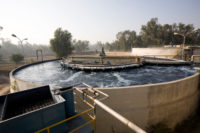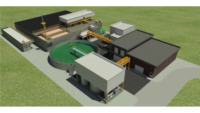Processing Technology
Exceeding stringent wastewater standards

Jim Marnatti, director of environmental affairs for Foster Farms, at the company’s biological nutrient removal (BNR) system at its Livingston, Calif., facility, during The National Provisioner’s visit in spring 2016.
Water is a critical element to safe food production. In turn, processing wastewater is consistently at the top of processors’ challenges as they continue to look at wastewater treatment systems advancements, water conservation and water recycling.
As a poultry producer that operates in seven states, the protection of local land and water is a top priority for Foster Farms. Conservation and effective wastewater management are an important part of how the company does business along with meeting stringent standards for food safety, says Jim Marnatti, director of environmental affairs for Foster Farms. Livingston, Calif., where Foster Farms’ headquarters is located, has very stringent environmental regulations compared with other states. For example, wastewater discharge limits are much lower than many other states.
“As a California company, we take pride in meeting these stringent standards and leading our industry in the process,” Marnatti says. The timing of permitting water projects in California also requires advance planning. For example, the Central Valley of California has strict water regulations and a lengthy permitting process.
“Such lead times limit a company’s ability to react to market conditions and be nimble,” Marnatti explains. “Water projects, including wastewater permitting, require the involvement of professional engineers and consultants, which can be expensive. As an example, maintaining wastewater permits can cost close to $100,000 per year between annual permit fees and annual monitoring expenses. For these reasons, wastewater developments must be planned well in advance in order for them to be implemented in a timely fashion.”
Most recently, with the drought in California, water availability also has become a challenge. The state governor’s water reduction mandate requires all communities to reduce water use by 25 percent or more. In addition, water usage fees have been increased significantly.
“Foster Farms has implemented multiple water savings initiatives in Livingston to ensure that the company does our part to conserve water and meet — or exceed — the governor’s objectives,” Marnatti says. “This year alone, Foster Farms’ water savings are in the hundreds of millions of gallons.”
Similar to Foster Farms, one of Cargill’s current challenges includes continually adjusting its processes to meet extensive requirements set forth within individual states and governing bodies, says Scott Hartter, vice president of environment, health and safety for Cargill Protein in Wichita, Kan. For example, limits for nitrogen and phosphorus have become much tighter in recent years. Additionally, processes that vary for Cargill across facilities and are dependent on the volume of product being processed, such as sanitation and food-safety processes that require chemical usage, can create difficulties to maintain the biological system health, he says.
Improving efficiencies
These companies are taking steps to combat these challenges and improve wastewater treatments in their facilities. For starters, Cargill consistently sets water conservation target goals throughout the organization.
“Since 2005, efforts have improved our freshwater efficiency by 12 percent,” Hartter says. “We are currently working toward a goal of improving efficiency by an additional 5 percent by 2020. Specific to our North American protein businesses, we have reduced water usage by 15 percent in the past decade.”
Many of Cargill’s beef processing facilities provide about half of the treated wastewater supply to local farm irrigation, displacing the need for groundwater irrigation. “In fact, two of our beef facilities, located in Friona, Texas, and Dodge City, Kan., provide 100 percent of their treated wastewater to local farm irrigation,” Hartter says. “Our facility design and operations have built-in water recycling systems to safely use water several times before its final discharge.”
Cargill also continually monitors and upgrades its systems to treat wastewater effectively. Recently, the company invested heavily to upgrade its systems in several plants, installing new technologies that help enhance nutrient removal processes. In addition to the systems already in place, Cargill’s employees are always searching for ways to implement low-to-no-cost behavior-based solutions to conserve water, Hartter says.
Cargill also recently announced a two-year partnership with World Resources Institute (WRI) to work across value chains and better manage deforestation and water risk.
“Cargill is committed to working with WRI to identify and reduce water risk, providing updates to the Aqueduct Water Risk Atlas, which uses robust, peer-reviewed methodology to provide best-available data in order to create global maps of water risk,” Hartter says. “We are also working with WRI to develop a methodology to evaluate water quality impacts on freshwater systems using open source datasets that describe the origin and fate of freshwater nitrogen and phosphorous fluxes. This will be pilot tested in the U.S. and will ultimately help Cargill identify opportunities to improve water quality in the communities where our businesses operate.”
Additionally, Cargill will join the Skoll Global Threats Fund to support WRI’s water program in development of the first Global Water-Food Security Analyzer, which aims to leverage existing information and science to manage environmental and economic risk associated with agriculture around the world.
“This partnership with WRI and Cargill will allow WRI to enhance its data and indicators provided in Aqueduct, and improve current measures of water-related business and supply chain risks companies around the world face,” Hartter explains. “These risks, such as droughts, floods and water supply variability could ultimately have an impact on the bottom line.”
Foster Farms also has initiated several major wastewater treatment projects. The company has automated wastewater pretreatment processes, including installed turbidity meters and real-time data collection systems, to maximize efficiency and compliance. Foster Farms also has installed advanced biological nutrient removal (BNR) facilities, such as activated sludge systems, at multiple sites to minimize the impact of its wastewater on the environment. Additionally, Foster Farms is using innovative enzyme and biological treatments to naturally pretreat wastewater, protect the environment and enhance compliance efforts. Foster Farms has initiated multiple wastewater reuse projects that supplant fresh water use, saving significant amounts of water per year as well.
“In Livingston alone, our water conservation and recycling initiatives are expected to save an estimated 900 million gallons of water per year — a 40 percent overall reduction,” Marnatti says.
In addition to its Livingston facility, Foster Farms also has recently completed wastewater pretreatment enhancements at another facility that will reduce chemical and wastewater solids volumes. The company is installing an equalization basin that will enhance the current wastewater system in Livingston by more uniformly controlling its pH and allowing it to lower chemical use.
Foster Farms has reduced some costs by changing wastewater pretreatment chemicals at two facilities. “The chemical change reduced the amount of solids generated in several of our wastewater pretreatment systems by approximately 50 percent while concurrently reducing wastewater treatment chemical usage without reducing wastewater pretreatment quality and lowering transportation and disposal costs,” Marnatti says.
With the start of the BNR effluent recycling effort, the project that is expected to yield a water savings of 900 million gallons per year, Foster Farms will realize a short-term savings in water costs, an approximate 40 percent reduction in annual water expenses. But, as the company has seen at multiple locations, municipalities ultimately adjust their water rates, which eliminates this savings, Marnatti says.
As Cargill continues to implement more practices that help reduce water usage within its facilities, the company also sees correlated reductions in energy use, which together provide the added benefit of cost savings. Investments made to upgrade technology also provide improved efficiency. For example, new filtration technology is becoming more cost effective, aiding water reuse opportunities, Hartter says. More complex systems, such as advanced activated sludge systems designed for advanced denitrification and biological nutrient removal, can significantly offset increased operating costs while addressing other wastewater challenges, he adds.
On the horizon, Foster Farms sees several reclamation systems available to clean up in-house and effluent water streams. “Some systems include multiple filtration steps along with water quality monitoring and chemical intervention prior to re-use,” Marnatti says.
Where hardness or other water impurities are an issue, ultra-filtration and reverse osmosis technologies are available. “In this area, it allows second use water to be used as possible boiler and condenser tower make-up water,” Marnatti says.
Foster Farms’ goal has been to maximize the efficiency of its existing systems while upgrading its processes wherever possible and as new, viable technology allows. “Our water recycling program is an example of how we increase efficiency and reduce waste systemwide,” Marnatti says. “The technologies we employ are based on constant review of our practices and identifying areas to maximize efficiency and protect valuable resources, like water.” NP
Looking for a reprint of this article?
From high-res PDFs to custom plaques, order your copy today!








